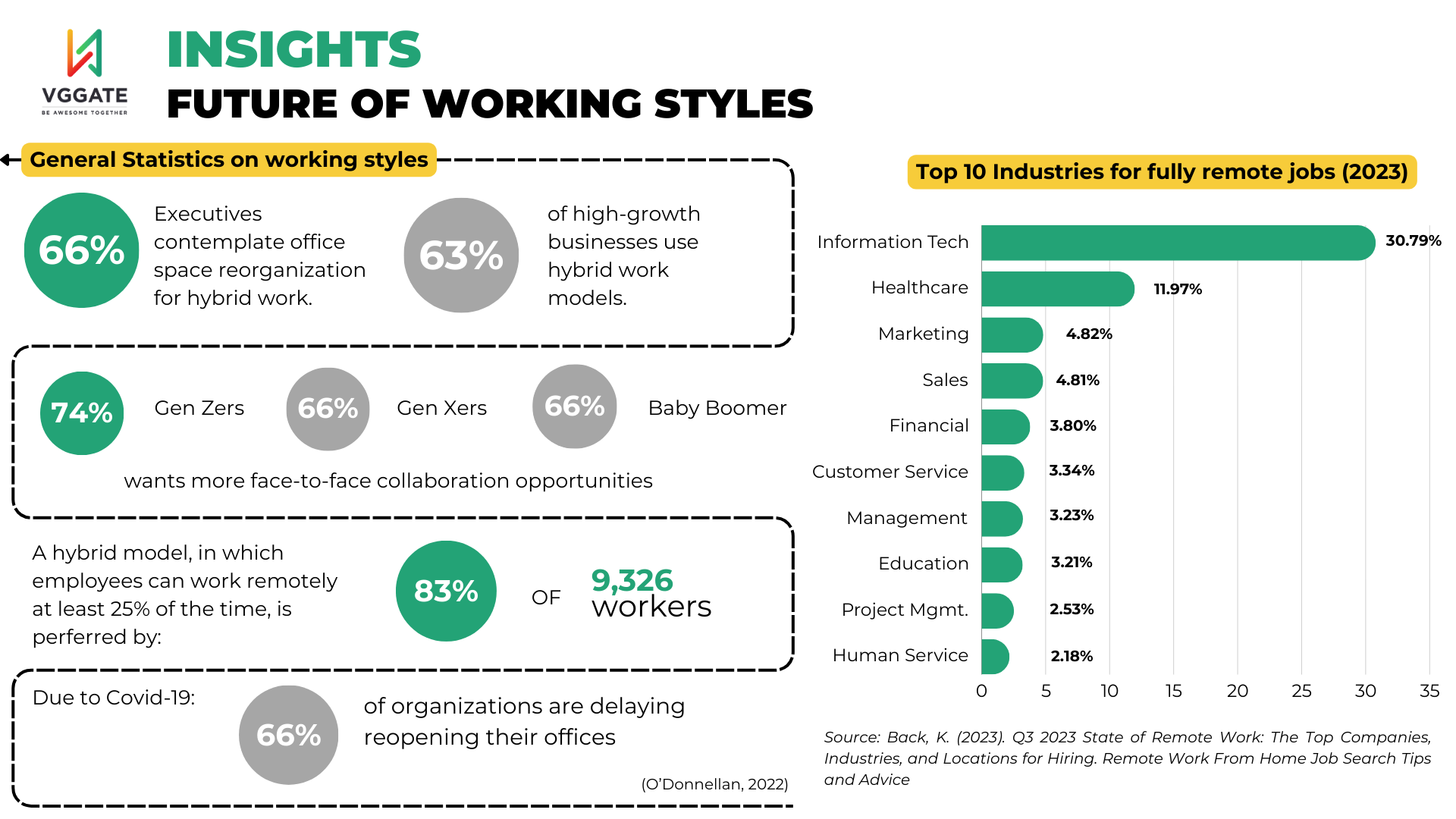The integration of technology into the professional sphere, especially in the IT industry, has reshaped traditional working norms. Remote work, once a rare occurrence, surged to 60% during COVID lockdowns, challenging the pre-pandemic norm of less than 5% remote workdays (Nick Bloom/WFHResearch, 2023). Despite the gradual return to physical offices, a new equilibrium has emerged, showcasing the enduring appeal of remote work. This shift is not just a response to the pandemic but also a reflection of ongoing technological advancements, offering an expanded array of workstyle choices. The article below will summarize all working styles, their advantages and disadvantages, and the future of working styles.
Definition
- Remote Work: Remote work is a working model where employees are not required to be physically present at the office or a specific workplace. Instead, they can perform their tasks from anywhere, primarily using the internet.
- On-Site Work: On-site work is a working model where employees carry out their tasks at the office or a specific workplace, typically being directly managed and supervised by the company.
- Hybrid Work: Hybrid work is a blend of remote work and on-site work. Employees have the flexibility to work remotely on some days, and this is often combined with in-office work on other days.
Disadvantages and Advantages of remote work
1. Advantages
Global Talent Pool: Remote work allows IT companies to outsourcing to a global talent pool. They can hire skilled professionals from diverse geographical locations, bringing in a variety of perspectives and expertise (Owl Labs).
Cost Savings: Remote work can lead to cost savings for both employees and employers. Companies can reduce expenses related to office space, utilities, and other overhead costs. Employees, on the other hand, save on commuting costs and time. Employees value working from home as much as an 8% pay increase. In tech and finance, employees value hybrid remote work at up to 11%. (Stanford) Companies in Australia can save $7,579 per employee per year on office space and lower wages by hiring remote talents in lower-cost labor markets. (B2BHQ)
Increased Productivity: Many IT professionals find that remote work boosts their productivity. The flexibility to create a personalized work environment, fewer interruptions, and the ability to focus on tasks without the distractions of an office can contribute to increased efficiency. According to a Survey from FlexOS: 66% of managers saw increased productivity, 48.5% said productivity has ‘significantly improved.’ Only 2% saw a decrease in productivity.Managers said their own productivity has significantly improved (38%) and not decreased (96%)
Work-Life Balance: Remote work allows IT professionals to better balance their work and personal lives. The flexibility to set their own schedules and work from home contributes to improved well-being and job satisfaction. Hence, offering remote work options can be a valuable retention strategy. Remote work reduces quit rates by 35% (Stanford) and 43% of employees would consider quitting if requested to be in-office full-time (FlexOS).
2. Disadvantages
Communication Challenges: Remote work can lead to communication challenges, especially when teams are distributed across different time zones. Miscommunication and delays in responses can occur, impacting collaboration and project timelines. Managers may find it challenging to monitor and supervise remote employees effectively. 36% of remote managers say the lack of face-to-face interactions is one of the main challenges in their work. (FlexOS)
Isolation and Loneliness: Working remotely can be isolating, and some IT professionals may experience feelings of loneliness or a lack of connection with their colleagues. Building and maintaining a strong team culture and camaraderie can be more challenging in a remote setting. The number one reason why hybrid employees come to the office is “to work with my team.” (McKinsey)
Security Concerns: IT projects often involve sensitive data and information. Remote work introduces security concerns related to data protection, secure communication channels, and the use of personal devices for work tasks.
Technical Challenges: Remote work relies heavily on technology, and technical issues such as internet outages, hardware failures, or software glitches can disrupt productivity. Technical support may not be as readily available as it would be in an office setting.
Disadvantages and Advantages of on-site work
- Advantages
Real-time Collaboration & Communication: On-site work allows for immediate and face-to-face collaboration. Team members can quickly discuss projects, resolve issues, and engage in spontaneous interactions, fostering a collaborative and dynamic work environment. Studies show that people who work in an office spend 52% more time collaborating than they would if they worked in full-time remote positions.(Boskamp, 2022)
Access to Resources: On-site employees have direct access to all the resources available within the office environment. This includes specialized equipment, high-performance hardware, and on-site technical support for immediate problem-solving. On-site work also allows organizations to conduct in-person training sessions, workshops, and skill development programs.
Enhanced Security Measures: On-site work allows organizations to implement and control robust security measures within the physical office space. This can be crucial for protecting sensitive data and maintaining a secure IT infrastructure.
Team Building and Company Culture: On-site work facilitates team building activities, social interactions, and the development of a strong company culture. In-person events, meetings, and shared experiences contribute to a sense of camaraderie among team members. According to an Envoy survey, the majority (60%) of employees said that friendships made in the workplace help drive a sense of belonging at work.
Clear Work-Life Boundaries: On-site work helps establish clear boundaries between work and personal life. Once employees leave the office, they can disconnect from work-related tasks, reducing the potential for work-related stress bleeding into personal life. According to our At Work report, 96% of executives notice the work done in the office far more than the work done at home. (Envoy)
2. Disadvantages
Geographical Constraints: On-site work may limit access to a global talent pool. Organizations may struggle to attract or retain skilled professionals who are not willing or able to relocate to a specific geographic location.
Dependency on Physical Infrastructure: On-site work relies heavily on physical office infrastructure. Disruptions, such as office closures due to emergencies or natural disasters, can significantly impact business continuity.
Limited Work-Life Balance: On-site work typically follows a fixed schedule, providing limited flexibility for employees makes it challenging for employees to achieve a healthy work-life balance. Strict office hours and commuting challenges, including traffic congestion, long travel times can contribute to stress and burnout.
Higher Overhead Costs: Maintaining physical office spaces involves overhead costs, including rent, utilities, and office supplies. This can be a financial burden for organizations, especially in times of economic challenges.
Future of working styles
66% of executives considered reorganizing company office space to accommodate hybrid work.
63% of high-growth businesses use hybrid work models.
A hybrid model that works for all generations could be difficult to come by: Three out of four Gen Zers (74%) want more face-to-face collaboration opportunities, compared to 66% for Gen Xers and 66% for Baby Boomers.
A hybrid model, in which employees can work remotely at least 25% of the time, is preferred by 83% of 9,326 workers polled in one survey.
92% of those polled in one survey expect to work from home at least once a week, and 80% expect to work from home at least three times a week.
Hybrid work is the dominant model: 49% of global desk workers work in a hybrid arrangement, 35% work full-time in-office, and 17% work full-time remote. But, 66% want a hybrid model. (Future Forum, 2022)
According to Virtual Vocations, across July, August, and September 2023, there were 2.57 times as many fully remote information technology remote jobs available as openings in any other field. And among the top 10 industries for fully remote jobs, customer service positions boasted the most growth throughout Q3.
The top industries for remote workers in 2023
- Information Technology (30.79%)
- Healthcare (11.97%)
- Marketing (4.82%)
- Sales (4.81%)
- Financial (3.80%)
- Customer Service (3.34%)
- Management (3.23%)
- Education (3.21%)
- Project Management (2.53%)
- Human Services (2.18%)
In short, the combination of remote and on-site work is shaping the future of the professional landscape industry. While remote working provides a global talent pool and saves costs, it also brings challenges such as communication issues. On-site work offers real-time collaboration but faces limitations such as higher costs. The future seems to favor hybrid models more than other models, aligning with the result of our previous poll. As we progress, the workplace will transform into diversity, emphasizing flexibility, innovation and comprehensive professional experiences.



